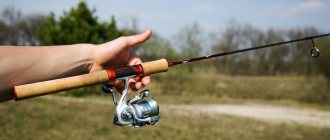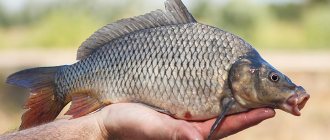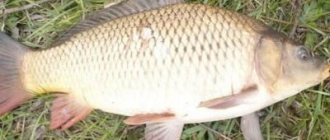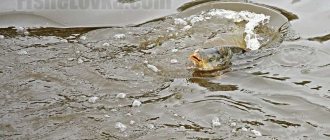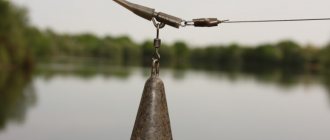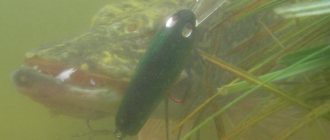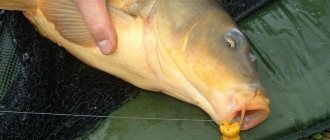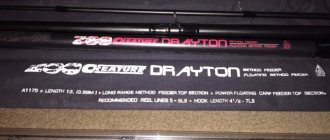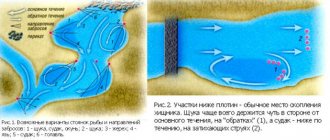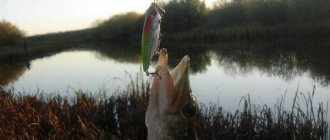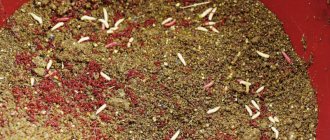How can a beginner find carp in an unfamiliar body of water? Where exactly should you look for it, and what should you use for this? What should you pay attention to and what should you put aside? How a carp “thinks”, and what generally guides it “through life”. The answers to all the above questions can be easily found in this article. And also (along the way) learn a few “tricks” used by experienced carp anglers. So, let's start in order.
Sometimes even children can find and catch carp. Naturally, under the guidance of my dad, the world’s most humble carp angler, Chris Douce.
Looking for carp feeding places
Most often, carp can be found in those places where it has long been accustomed to feeding. It is in these areas of the reservoir that there is a high probability that the fish will willingly take many of your baits. But here it is definitely worth mentioning that they can be not only natural, but also “artificial”. That is, created directly by carp anglers, by spreading bait. In other words, if you (systematically) throw bait into the same areas of a lake or pond for several days, then sooner or later the carp will begin to consider them natural. This means they are as safe as possible.
The most promising point for future fishing that needs to be baited will be the place on the reservoir where the fish will feed without any fear. Therefore, if you suddenly notice that the carp in the area you have chosen feed reluctantly (and carefully), then you need to immediately look for other places where they will feel quite comfortable. For this purpose, you should definitely take into account the following nuances of finding the best bait point:
- the nature of the bottom of the reservoir (lake or pond);
- features of flora and fauna in the reservoir;
- the area of the reservoir and the quality of its water;
- specific features of the lake or pond;
- the presence of “competing” fishermen on the shore.
The nature of the bottom of the reservoir
Before each carp fishing, it is very important to “calculate” all the specific features of the bottom of the reservoir. Since it is where various species of living organisms live, in search of which carp spend virtually all of their time. Their “delicacies” are all kinds of crustaceans, worms, larvae/pupae (chironomids), snails or molluscs. At the same time, in one season, carp prefer to eat one of these types of food, in another - completely different ones. This point must be taken into account!
Thus, in order to know where to look for carp in a pond, you need to clearly understand: WHEN and WHAT “food items” it especially likes. And most importantly, where do they live? So, for example, if snails live almost everywhere on a lake or pond, then small (protein-rich) worms or chironomids live only in silt. Or in some bottom sediments, for example, detritus. By properly scouting the bottom using a marker, you will additionally learn about what microorganisms live there (specifically), and whether the carp like them during this particular period of time.
A couple of useful tips
If the depth allows, go into the water and get a handful of silt to see who “lives” in it (i.e., what microorganisms). Smell it, taste it. Naturally, you need to learn to recognize them. That is, you will need to devote some time to a detailed study of all the “delicacies” of this fish. Search the Internet on your own for scientific information (for example, about the characteristic tastes and smells of their habitat), as well as the most accurate photographs.
searching for carp and determining where to feed
We would not be far from the truth if we say that locating carp, or, more importantly, identifying where they feed, is a key link to success in fishing. Very often we hear questions from anglers regarding bait, equipment, search and other things - depending on what each of them considers most important.
The answers vary widely, but since this is our book after all, we will talk about our personal fishing strategy, and at the center of it is location, that is, finding carp and identifying their feeding areas. Why do you need the most advanced equipment and the most amazing bait if there are no carp in the lake? The same applies to choosing a fishing spot. This is the simplest explanation of our principle. Firstly, find the carp, secondly, determine where it goes to feed, and your life will become much easier. Remember: the most perfect equipment and excellent bait do not play the main role, as some advertising publications describe. If this were true, then anyone equipped with the most modern equipment would be able to catch fish anywhere, anytime. But this is far from true.
So where do you start looking for carp? All bodies of water are different from each other, just like all carp. This is the main reason for all the difficulties. The only way to make your life easier is to start with the basics and work your way up. Therefore, in this chapter we will start from the very beginning: we will look at the four main methods of location. These are visual, auditory, mechanical and conversational methods. Such a classification of methods is quite natural. Firstly, we can see the carp with our own eyes. Secondly, we can hear it. Thirdly, we can detect its presence using mechanical means, in particular an echo sounder. And finally, we can learn about the presence of carp in a particular place from conversations with other anglers. Of course, any of us prefers to see carp with our own eyes - this will give an absolute guarantee that there are carps in this place. But ideally, it would be not just to see the carp, but to determine where it feeds. This is precisely the crux of the search issue.
How to “create” carp feeding places yourself?
Very often, experienced carp fishermen artificially create natural feeding areas for carp. Of course, the easiest way to do this is in those reservoirs where many crustaceans live - considered by carp as a safe and natural source of food. That is, the plan is as follows: first, you need to attract as many crustaceans as possible to a certain area of the pond, which will definitely lure fish there. Which will be very willing to eat not only these delicacies, but also our bait. Just in order to attract crustaceans, you need to figure out those places on the pond or lake where they will feel safe.
Let's give a simple example of how this all looks in practice. Ideal areas of the bottom (for attracting crustaceans) are located at a depth of about 10 meters, i.e. where there is almost no sunlight. After all, we all know that the sun’s rays can penetrate through water only to a depth of 10 meters. And, although, closer to the surface, there are also many food items for crustaceans, but it is at this depth that they are practically invisible to many predators! For this simple reason, many Karpol fishermen call a depth of 10 meters “depth for crayfish.” Because, first of all, they feel absolutely safe there! But, only during the day. At night, when it gets fairly dark, the crustaceans “get bolder” and necessarily migrate to shallow water. To diversify your diet and “breathe” oxygen.
Conclusion: if you find out that carp in a pond love to eat crustaceans, then your bait should be at a depth of about 10 meters during the day, and at night in shallow areas (somewhere nearby). In order to increase the effectiveness of the bait program, first you need to scatter soft types of bait (i.e. for crustaceans), and then harder ones (for carp, respectively).
How to determine the location of carp?
What should I do if I don't know where the carp feed? If there are no fish in sight, or you see no visible signs of their presence, then you should make educated guesses about where the carp are living and feeding at different times of the day. To do this, you will have to use all your knowledge and experience to guess where you think he might be. Of course, this is easier to do if you fish in bodies of water that are familiar to you. If this is your first time on the lake, ask other carp fishermen, they probably know the main trails and habitats of their main hunting object.
The most important thing you should know is that carp will always try to feed mainly in those places in which they feel safe. That is why, when choosing a place on a reservoir, it is first of all better to focus not on a comfortable location on the shore, but on the basis of where it is most difficult for most anglers to reach, where the fish feel most calm.
Fortunately, the range of carp equipment is now so improved that you can organize your life in any conditions, regardless of the rough terrain on the shore.
Tips on how to find carp
The task is quite difficult, especially if there is a strong cross wind blowing on the lake. But there are basic things to pay attention to. When you arrive at the pond, try to watch the water for a while. It is very likely that you will be able to see fish hatches. If the body of water is very large, then it makes sense to take binoculars.
Walk along the shore. If the water is calm, you may notice bubbles near the reeds. If this is a chain of bubbles that gradually rise from the bottom, this is a sure sign of a feeding fish. Of course, it may not be carp, but another fish. But still, such information will indicate that there are fish in this place!
The best advice is to choose a spot away from other anglers. Try to get away from fishermen as much as possible. A large amount of gear and bait can force the fish to temporarily leave this area of the reservoir. Even when someone catches fish periodically, most likely it is a passing, random fish.
If all the places are occupied, then you will have to tune in for a long cast. At least, further than your neighbors throw. By the way, we have already written about fishing tactics in pressed-in reservoirs - the link is here.
Hot Spots
Look at the visible outlines of the body of water you are on. The most common places where carp like to feed will be:
- Trees overhanging the water
- The shore where the wind blows
- Reed thickets
- Islands in the middle of a body of water
- Snags, fallen trees sticking out of the water
Trees overhanging the water . One of the best places to place your bait. If this is your first time on a pond, you should almost certainly try fishing at this point. The overhanging branches of the trees provide the carp with a large amount of food, and it also feels safe there because the tree shelters it from the encroachments of anglers from the shore.
Very often large fish were caught not only 150 meters from the shore, but also not far from land, just from under the branches of trees. Remember that most anglers tend to cast far, completely bypassing short distances.
Remember that carp associate overhanging tree branches with lots of food and safety - this is one of the hottest spots on the pond!
The shore where the wind blows . The wind can greatly affect the movement of the fish. It is a very common belief that fish follow the wind, so most often the shore where the air masses are moving is the best to fish. According to a well-known theory, the wind drives all the nutrient particles, and the carp naturally follows them.
There is also a theory that the wind is able to “move” the thermocline several meters deeper, thus warm water penetrates closer to the bottom and it is easier for fish to sink to the bottom to look for the same bloodworm in the silt, and so on. And that’s where the equipment is located.
Watch the direction of the wind - often this becomes a decisive factor in the successful outcome of fishing!
Thickets of reeds . Another favorite place for fish to live. But keep in mind that carp do not feel as safe near the reeds as they do near large trees. Much will depend on how confidently the fish are feeding.
But you definitely need to examine the reeds for feeding fish and try not to make noise under any circumstances, because fishing can be carried out almost 10 meters from the rod-pod.
Islands in the middle of a body of water . Again, if you see overhanging trees on the island, this is a sure sign that carp will definitely appear there during the day. The fish can freely patrol the area around the island. Often the islands are located some distance from the coast, so not every fisherman can throw his gear there.
It makes sense to always keep in mind the option that you will have to “reach” the fish and have a separate spool with a thin line in stock for long casting!
Snags, fallen trees sticking out of the water . Probably the safest place for fish. She hides there from predators and feels completely safe. However, fish do not always feed near snags. Therefore, it makes sense to check this point, but also look for other points in advance. In general, on an unfamiliar body of water, we would recommend starting fishing from several different places.
We recommend reading the article with tips on catching carp in snags!
It also makes sense to pay attention
- Underwater thickets and water lilies are places that carp like to visit in search of food, especially in summer. There he will definitely find crustaceans living among plants at different depths.
- Frequently visited places are streams and rivers flowing into the lake.
- Aerators or fountains , in short, anything that sprays water, because they are excellent sources of oxygen, especially on hot days.
- Large sunken objects such as fallen trees, wheels, carts. When looking for a trophy, it would be a good idea to look here first.
- Coastal embankments that extend into the depths of the lake. Carp can visit them at any time of the day.
- Also find out if there are any depth changes or holes . Carp often patrol various slopes and edges, as they can always find something edible on them.
- On warm days, the best places for carp to stay may be shallow water , and on cold days , deeper water . The same thing happens when it starts to get cold during the session: the carp goes deeper. Therefore, when searching for it, you will have to take into account general weather conditions.
Full or partial copying of site materials without the consent of the editors is prohibited.
Where else can you look for carp?
More advanced carp anglers (naturally, with many years of experience) immediately look for carp in 3 main directions:
- where it can feed (i.e. the feeding areas described above);
- where he feels safe (for example, snags or holes in the depths);
- and, accordingly, the “paths” along which he “walks” from his shelters towards the “dining room”.
In principle, the entire life cycle of carp is not particularly complex and boils down to feeding, reproduction and searching for calm/safe places. If we define all his basic needs with a list of priorities (on a descending scale), it will look like this:
- breathing (i.e. the vital need for oxygen);
- nutrition (for growth and energy replenishment);
- safety (according to the natural instinct of self-preservation);
- reproduction (for procreation).
However, all this information should not be considered universal, i.e. suitable for absolutely any carp fishing conditions. Since many external factors can seriously influence the behavior of carp several (!) times during the day. And the first of them is the weather.
Influence of weather conditions
Sunlight (or more precisely, thermal radiation) is one of the most important conditions for maintaining life on our planet. Without heat rays, all living things will quickly die. And carps are no exception. Not only the water temperature or light conditions at depth, but also the important process of oxygen dissolution depend on them. In addition to thermal radiation, the behavior of fish is influenced (no less) by wind, rain and atmospheric pressure.
You can learn more about the influence of wind, rain and atmospheric pressure on the behavior of carp in our article:
Best for carp fishing - weather, wind and pressure
Other
Bait and bait
Carp is an almost omnivorous fish.
However, according to a number of specific parameters, bait and bait for carp in different areas can differ radically:
- The easiest way to use commercial bait is to use ready-made mixtures. It is enough to dilute them with water from a reservoir and let them brew for a while;
- For a budget option, bait prepared with your own hands is suitable. The basis is porridge (millet, peas, corn) and diluted with other components (steamed wheat grains, boiled potatoes, cake);
- You can use store-bought boilies or groundbait ingredients, as well as animal bait as bait.
A mandatory principle for catching any fish, including carp and carp, is that it is necessary to add to the bait the attachment (bait) that you are going to fish with.
